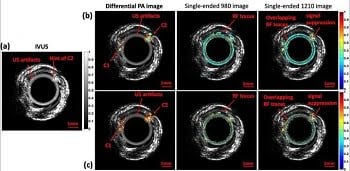Researchers from the University of Toronto (U of T) have developed a cholesterol-detection imaging technique using laser photoacoustics and continuous wave lasers to allow for more timely treatment of atherosclerosis.
"This new modality can detect true cholesterol signals in plaques," Andreas Mandelis told Photonics Media. Mandelis is professor of mechanical and industrial engineering and electrical and computer engineering at the U of T, and one of the authors of an article describing the method.
Mandelis and colleagues have demonstrated a detection technique that combines laser photoacoustics, a hybrid optical-acoustic imaging technology, with low-power continuous wave lasers and frequency-domain signal processing, in an approach known as photoacoustic radar. This advanced technology can accurately evaluate plaque-based cholesterol.
Cholesterol in plaque — along with fat, calcium, and other blood-transported substances — can lead to atherosclerosis, a disease that can cause heart attacks or strokes. Early detection of cholesterol can lead to earlier treatments and improved health outcomes.
Mandelis said, "A novel wavelength-modulated intravascular differential photoacoustic radar (IV-DPAR) modality was introduced as an interference-free detection technique for a more accurate and reliable diagnosis of plaque progression."
“By using two low-power continuous-wave laser diodes in a differential manner," he said, "IV-DPAR could efficiently suppress undesirable absorptions and system noise, while dramatically improving system sensitivity specifically to cholesterol, the primary ingredient of plaque necrotic core. When coregistered with intravascular ultrasound imaging, IV-DPAR could sensitively locate and characterize the lipid contents of plaques in human atherosclerotic arteries, regardless of their size and depth.”

Normalized 14-MHz IVUS image of the atherosclerotic artery phantom by IVUS at 14-MHz (a). Normalized PAR amplitude (b) and phase images of IV-DPAR, single-ended 980-nm PAR and single-ended 1210-nm PAR modes (c). The same endoscopic transducer and instrumentation were shared by IVUS and IV-DPAR for coregistration. C1: cholesterol sample 1; C2: cholesterol sample 2. Courtesy of Sung Soo Sean Choi et al.
"Conventional pulse-based multispectral photoacoustic modalities rely on simple subtraction algorithms of sequentially processed signals which may cause undesired artifacts," Mandelis said. "When coregistered with intravascular ultrasound (IVUS), IV-DPAR could reveal a complete cross sectional image of lipids in animal coronary arteries and human aorta that delivers accurate location and quantitative radial depth-profiles of atherosclerotic disease."
Making this approach unique, according to Mandelis, is its single-ended laser-pulse-based intravascular photoacoustic technique.
“Its key advantage is that it is only sensitive and specific to spectroscopically defined targets (atherosclerotic plaque lipids), without being affected by other interfering light absorbers present in artery walls or instrumentation-generated noise signals,” he said.
The science has not yet been tested in clinical studies, but Mandelis said it should become available in about a year.
“IV-DPAR imaging technology needs to overcome one more hurdle: Our laboratory prototype needs to adopt a smaller ultrasonic transducer (about half the size of the current 1.5 mm device) in order to fit inside a human coronary artery while it responds to laser beam modulation frequencies in the 30 MHz range.”
According to Mandelis, several clinical atherosclerotic imaging methods currently exist but lack the same level of information or fail to deliver information that reliably differentiates between various forms of soft plaque.
“Angiography is the major coronary artery imaging modality but it substantially lacks morphological or compositional information of plaques other than the extent of calcification,” he said.
The research was published in the SPIE Journal of Biomedical Optics (https://doi.org/10.1117/1.JBO.24.6.066003).